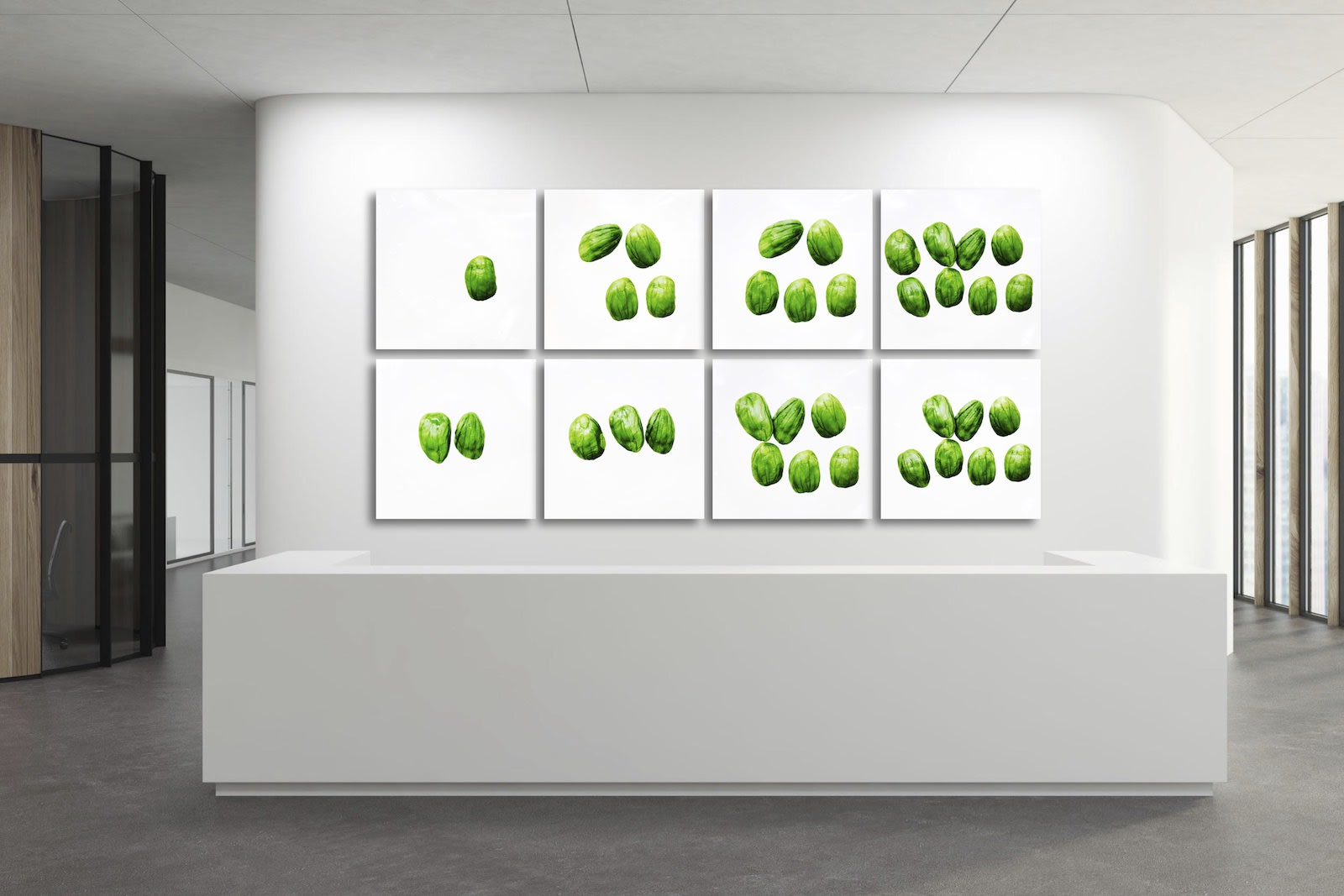Mamakan’s fine art photography proposes a new contemporary version of impressionism, where she captures a moment of flora in natural light, using movements to create a play of light and water reflections, often expressed in bright, intense colour vibrations or calming black & white. These works are highly intuitive, feeling and portraying the natural essence, or perhaps even the soul, of a plant, in a bold, handmade composition arising from the artist’s air of spontaneity.
Her large-scale installations are known for their experiential and sensorial qualities, where she immerses the visitor into living the story using visuals, touch, sounds, scent and sometimes even food & drinks. By exploring different aspects of botanicals through these interactive and immersive art experiences, we discover new connections with nature, our senses, ourselves and history.
Nothing on Earth Grows in Heaven, Maybe
The Old World Tropics are home to the nutrient-rich winged bean (Psophocarpus tetragonolobus), so called for the wings that run along its length. All the parts of this flying bean are edible, prompting some scientists to dub it “a supermarket on a stem” and “the wonder legume”. Although this humble plant is much under-utilised, it has the potential to become a major multi-use food crop in the tropics.
A Straightforward Guide to Bean Counting
Not all that can be counted should be counted. Or counted in the way that you are familiar with. When it comes to complex issues like climate change, using simple numbers distracts us from the complexity.
The moral obligation of humanity to take care of our most precious resource, our ancestral home, our planet, the mother that gave us life cannot be measured.
Parkia speciosa (petai), is a large tree plant in the family Fabaceae native to Malaysia, Brunei, Indonesia, peninsular Thailand and the Philippines (Palawan). The Petai tree bears long, flat edible beans with bright green seeds which have a rather peculiar pungent smell.
Far from your innocent sweet green peas, Petai beans reveals their presence, power and pungency. These beans will leave their odour inside your mouth and body for days, similar to asparagus.
Twisting Towards Balance
Only by twisting spiritually upwards, humanity will reconnect with nature, thereby releasing a healing burst towards ecological balance.
This work is made with the Parkia speciosa, known in South East Asia as the Petai Bean. The curved shape of the bean pods create a helix-like movement, a sensation of dancing upwards. The moving water symbols release and rebirth.
Catch Me If You Can
Amidst a global rise of nationalism and borders closing, who cares about the feelings of immigrants? Pushed around by authorities, moody electorates and extremism, today’s explorers are constantly on the lookout for more peaceful pastures.
Who cares about roots, just keep on running. Be strong, the next place may be more welcoming.
Love-in-a-mist (Passiflora foetida) is a botanical immigrant, unwelcome in parts of the world that seem to prefer uniform, ornamental garden flowers. Native to South America and found in the Amazon Rainforest, this weed has managed to travel to far and distant lands.
A strong climber with beautiful flowers and yellow, tasty passion fruits, this plant is less fragile than it looks. Raw leaves contain cyanid to defend animals from eating it and its fruits are covered by sticky, misty nets catching small insects before reaching the delicious fruits.
The specimens used for this work were growing wild around a garbage dump on Niven Road, Singapore. Like most wild weeds in Singapore, the mother plant has since been destroyed.
Five Excellent Sheep in Pursuit of Perfection
“Our system of elite education manufactures young people who are smart and talented and driven, but also anxious, timid, and lost, with little intellectual curiosity and a stunted sense of purpose… heading meekly in the same direction, great at what they’re doing but with no idea why they’re doing it.”— William Derisiewicz, author of Excellent Sheep: The Miseducation of the American Elite and the Way to a Meaningful Life.
Sentul (Kecapi or Sandoricum koetjape, from the Meliaceae family like rambai, langsat and sentang) is a native true to Vietnam, Laos, Cambodia, Thailand, Malaysia, Indonesia, Singapore and the Philippines. Its fruits are edible and full of vitamins B, C, potassium and phosphorus.
The yellow Sentul fruit skin is thick and tough hiding very soft, sweet, whitish and fleshy covered seeds. Sentul was never exported and is not known internationally. Traditionally used as a backyard plant, today Sentul is a rare and almost forgotten tree in its own native region of Southeast Asia.
In this work, Mamakan is using floating Sentul seeds as a reference to sheep following each other like school students without purpose. Except the first seed, that seems to be rather hesitant and reflective. Perhaps thinking about changing direction?
Fire Sparks Us, Stillness Sustains Us
The common name of Tapioca actually refers to the starch extracted from Cassava root (Manihot esculenta) native to the northeast region of Brazil, but carried by Portuguese and Spanish explorers to most of the West Indies and Africa and Asia.
In this work, the artist has chosen the red tapioca branches to represent the fire, the spark, the passion. Fire as wild and untamed, sometimes connecting, sometimes not. Always in pursuit of something explosive or expansive.
The space between the branches represents stillness, a kind of meditative and open state that is often overlooked by the business of the fire.
The specimens used for this work are from a small community garden in Tangkahen village, North Sumatra, Indonesia with the help of Ika, a local guide.
Mamakan
Mamakan is a Danish botanical artist inspired by the feminine spirit of nature. Her artistic practice uses fine art photography, poetry and sensorial installations to contemplate about our relationship with plants, flowers and trees at the most intimate level of the of the human mind, conscious and unconscious.
Her latest installation 'Daughter of the Soil' was commissioned by OH! Open House at Emerald Hill 2018 and featured the true story of Agnes Joaquim, a Singaporean born in the 19th century and the first woman in the world to crossbreed two orchid species.






